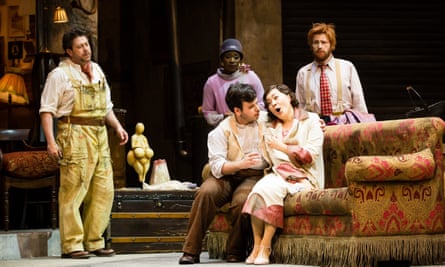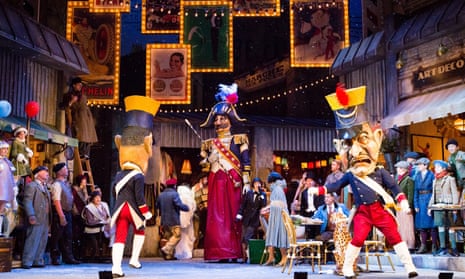Just as Puccini based his opera on Henri Murger’s “scenes of bohemian life”, Scottish Opera’s new production of La Bohème is – literally – an enormous vintage picture postcard of Paris. The curtain rises on a modern-day flea market, with tourists taking selfies, sellers touting their wares and a chansonnier accordion duo entertaining the crowd. Amid the bustle, a lone visitor puts a record on a vintage gramophone from which emanates the opening bars of a very famous opera, transporting the audience back in time. It’s a clever trick, but for all its postmodern framing this production of La Bohème is traditional at heart.
Canadian designer and director duo André Barbe and Renaud Doucet – the team behind Scottish Opera’s Don Pasquale in 2014 and Manon in 2009 – go in for beautiful and gloriously over-the-top productions and their Bohème is no exception. The setting is updated to the interwar years, the era when American artists and writers flocked to Paris to live the bohemian life. This allows for a Café Momus scene full of flamboyant jazz-era figures, including Jeanine de Bique’s glamorously exotic Musetta, a homage to entertainer Josephine Baker, pet cheetah and all.

Barbe and Doucet’s production plays up the humour and vitality of Puccini’s opera, aspects that are often subsumed in favour of the overwhelming sentimentality of the central love story. This is reinforced in the pit, where music director Stuart Stratford sets a brisk pace, particularly in the opening act. Here, Rodolfo and Mimì’s initial meeting is an interlude in the bustle of everyday life instead of an absolute hiatus in the action. Hye-Youn Lee gives a dignified, touching performance as Mimì, noble and poised with a quality of tone that carries over Puccini’s orchestration, while still giving the sense of her character’s fragility. She isn’t quite matched by Luis Gomes as Rodolfo, his voice is sweet-toned but underpowered for the ardour of the ecstatic moments.
There is strong support from Rodolfo’s fellow artisans: David Stout, a happy-go-lucky Marcello, Božidar Smiljanić, a serious-minded Schaunard and Damien Pass, an ascetic and somewhat melancholy Colline. The ensemble scenes between these characters are particularly successful, bringing out a bantering camaraderie. Underpinning the action, the Orchestra of Scottish Opera emphasised the lush sonorities of Puccini’s orchestral writing. At times, this came at the expense of balance: the orchestra was simply too loud to allow the singing to come through the musical texture.
Past and present intermingle throughout the production and although some of the later modern interjections don’t seem entirely convincing, Djordje Gajic’s accordion interlude before the final act is a nice touch. However, judging by the rapturous reception on the opening night, it is a crowd-pleasing production that should serve Scottish Opera well.
- At Theatre Royal, Glasgow, until 20 May. Box office: 0844 871 7647. Then touring until 17 June.

Comments (…)
Sign in or create your Guardian account to join the discussion